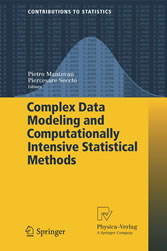Suchen und Finden
Title Page
1
Copyright Page
4
Preface
5
Table of Contents
7
List of Contributors
9
Space-time texture analysis in thermal infraredimaging for classification of Raynaud’s Phenomenon
11
1 Introduction
11
2 TheData
12
3 Processing thermal high resolution infrared images
13
3.1 Segmentation
13
3.2 Registration
13
4 Feature extraction
15
4.1 ST-GMRFs
16
4.2 Texture statistics through co-occurrence matrices
18
5 Classification results
19
6 Conclusions
20
References
21
Mixed-effects modelling of Kevlar fibre failure timesthrough Bayesian non-parametrics
23
1 Introduction
23
2 Accelerated life models for Kevlar fibre life data
25
3 The Bayesian semiparametric AFT model
26
4 Data analysis
28
5 Conclusions
34
Appendix
34
References
36
Space filling and locally optimal designs for Gaussian Universal Kriging
37
1 Introduction
37
2 Kriging methodology
39
3 Optimality of space filling designs
40
4 Locally optimal designs for Universal Kriging
41
4.1 Optimal designs for estimation
41
4.2 Optimal designs for prediction
46
5 Conclusions
48
References
48
Exploitation, integration and statistical analysis of thePublic Health Database and STEMI Archive in theLombardia region
50
1 Introduction
50
2 The MOMI2 study
52
3 The STEMI Archive
55
4 The Public Health Database
56
4.1 Healthcare databases
57
4.2 Health information systems in Lombardia
58
5 The statistical perspective
58
5.1 Frailty models
59
5.2 Generalised linear mixed models
60
5.3 Bayesian hierarchical models
61
6 Conclusions
62
References
62
Bootstrap algorithms for variance estimation in PS sampling
65
1 Introduction
65
2 The naïve boostrap
66
3 Holmberg’s PS bootstrap
67
4 The 0.5 PS-bootstrap
70
5 The x-balanced PS-bootstrap
70
6 Simulation study
71
7 Conclusions
76
References
76
Fast Bayesian functional data analysis of basal body temperature
78
1 Introduction
78
2 Methods
80
2.1 RVM in linear models
80
2.2 Extension to linear mixed model
81
3 Results: application to bbt data
84
3.1 Subject-specific profiles
85
3.2 Subject-specific and population average profiles
86
3.3 Prediction
88
4 Conclusions
88
References
89
A parametric Markov chain to model age- and state-dependent wear processes
91
1 Introduction
91
2 System description and preliminary technological considerations
93
3 Data description and preliminary statistical considerations
94
4 Model description
97
5 Parameter estimation
99
6 Testing dependence on time and/or state
101
7 Conclusions
102
References
103
Case studies in Bayesian computation using INLA
104
1 Introduction
104
2 Latent Gaussian models
105
3 Integrated Nested Laplace Approximation
107
4 The INLA package for R
108
5 Case studies
108
5.1 A GLMM with over-dispersion
108
5.2 Childhood under nutrition in Zambia: spatial analysis
110
5.3 A simple example of survival data analysis
115
6 Conclusions
117
References
118
A graphical models approach for comparing gene sets
120
1 Introduction
104
2 Latent Gaussian models
105
3 Integrated Nested Laplace Approximation
107
4 The INLA package for R
108
5 Case studies
108
5.1 A GLMM with over-dispersion
108
5.2 Childhood undernutrition in Zambia: spatial analysis
110
5.3 A simple example of survival data analysis
115
6 Conclusions
117
References
118
A graphical models approach for comparing gene sets
120
1 Introduction
120
2 A brief introduction to pathways
121
3 Data and graphical models setup
123
4 Test of equality of two concentration matrices
125
5 Conclusions
126
References
126
Predictive densities and prediction limits based onpredictive likelihoods
128
1 Introduction
128
2 Review on predictive methods
129
2.1 Plug-in predictive procedures and improvements
130
2.2 Profile predictive likelihood and modifications
131
3 Likelihood-based predictive distributions and prediction limits
132
3.1 Probability distributions from predictive likelihoods
133
3.2 Prediction limits and coverage probabilities
135
4 Examples
135
4.1 Prediction limits for the sum of future Gaussian observations
136
4.2 Prediction limits for the maximum of future Gaussian observations
138
Appendix
139
References
141
Computer-intensive conditional inference
142
1 Introduction
142
2 An inference problem
144
3 Exponential family and ancillary statistic models
145
4 Analytic approximations
146
5 Bootstrap approximations
147
6 Examples
149
6.1 Inverse Gaussian distribution
149
6.2 Log-normal mean
150
6.3 Weibull distribution
151
6.4 Exponential regression
152
7 Conclusions
153
References
154
Monte Carlo simulation methods for reliability estimation and failure prognostics
156
1 Introduction
157
2 The subset and line sampling methods for realiability estimation
158
3 Particle filtering for failure prognosis
161
4 Conclusions
166
References
167
Alle Preise verstehen sich inklusive der gesetzlichen MwSt.




















